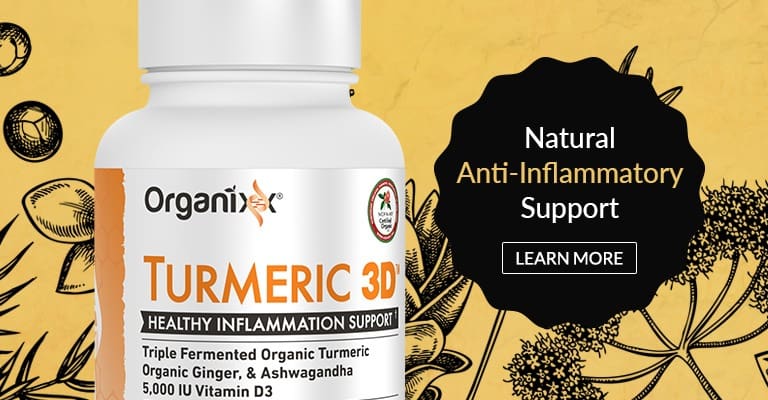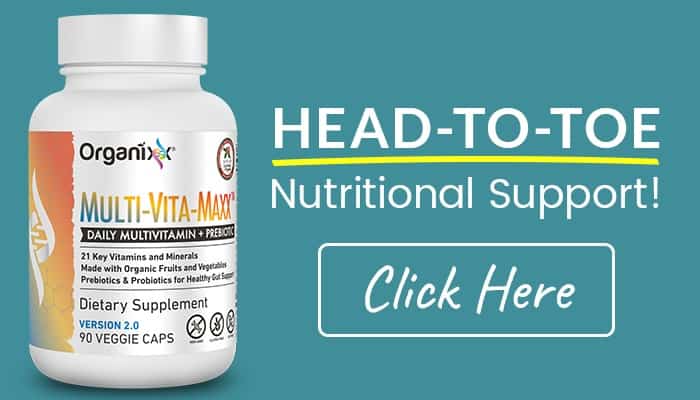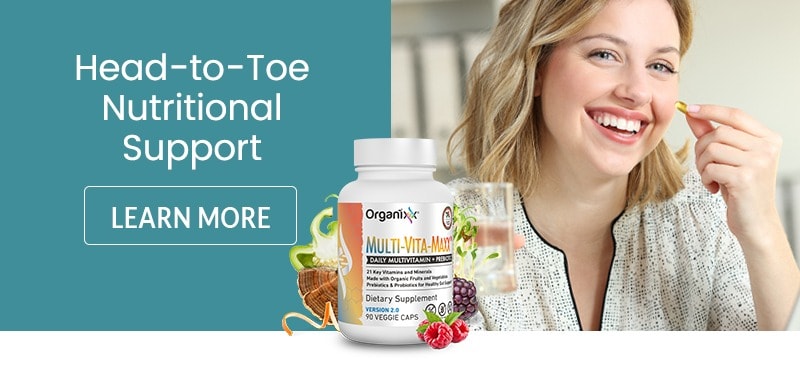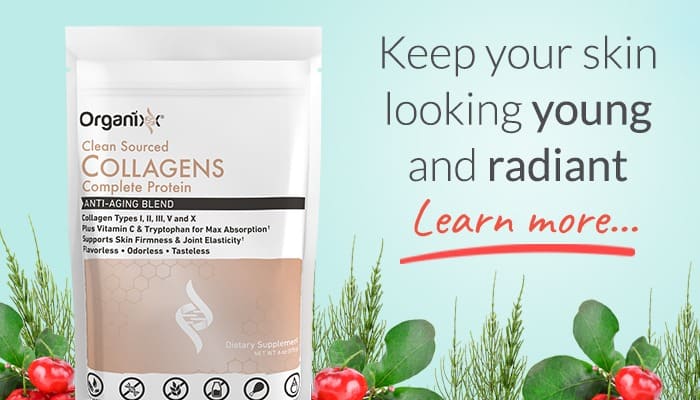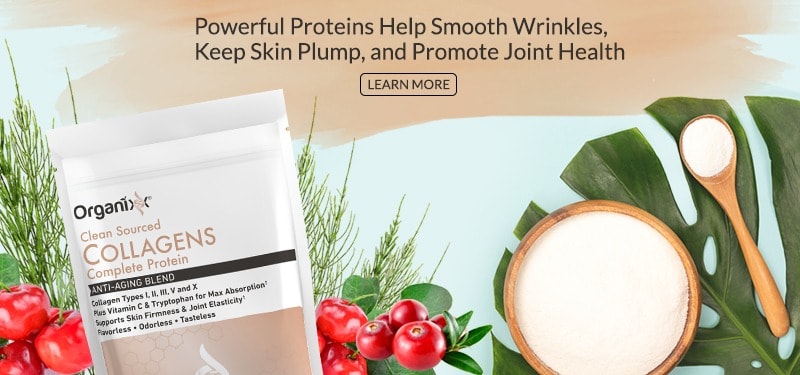Are you curious about the hype around pink Himalayan salt in healthy recipes?
If so, you’re not alone. This salt boasts dozens of minerals, including sodium, but how does it compare to other types of salt?
In this post, we’ll explore the benefits of pink Himalayan salt, as well as its iodine content to help you decide if it’s the right choice for your health and vitality.
Why Does the Body Need Salt?
What’s the Difference Between Sea Salt and Table Salt?
Does Himalayan Salt Have More Iodine Than Sea Salt?
What Is Himalayan Salt and Where Does it Come From?
The Benefits of Trace Minerals in Pink Himalayan Salt
Why Your Body Needs Iodine
Does Pink Himalayan Salt Have Enough Iodine to Correct Iodine Deficiency?
Don’t Rely on Salt to Meet Your Iodine Needs
Why Does the Body Need Salt?
Salt has been used by humans around the world since Neolithic (Stone Age) times. It has been used to flavor food, for meat preservation, for pickling, and as a healing substance. In Europe, the use of salt rooms (halotherapy) for healing and detoxifying goes back decades.
At the top of the list for both healing and taste is Himalayan salt. This rosy-pink crystalline salt has been used in the Ayurvedic tradition for thousands of years. Because of its pinkish color, you may see Himalayan salt referred to as “pink Himalayan salt” or “Himalayan pink salt.” It’s all the same substance.
The difference between quality and types of salt is something you should take into consideration if you’re wanting to lead a healthy, vibrant life.
The bottom line is that the human body needs salt. Specifically, it needs sodium chloride (NaCl), which is the chemical name for salt. Sodium in the body is an electrolyte and is absolutely essential for many bodily mechanisms and functions. This includes:
- nerve and muscle function
- maintaining fluid levels
- regulation of temperature
- blood pressure regulation
- and much more
What’s the Difference Between Sea Salt and Table Salt?
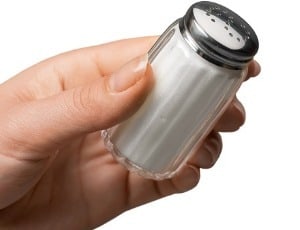
First of all, you should know that refined table salt (i.e., the tiny granules that come in those blue & white boxes at your local grocery store) hardly resembles what sodium chloride is in its natural form.
Today’s table salt is mined from underground stores. Once it gets brought up to the surface, it goes through a whole series of chemical processes before it winds up in a shaker on your table.
These processes include bleaching and baking (up to 1200 degrees) as well as the addition of many kinds of chemicals, including:
- anti-caking agents
- absorbents
- preservatives
All of this is designed to give table salt its customary fluffy, free-flowing texture and super white color. Needless to say, by the time it gets to your spice rack, there isn’t much nutrition left in it.
Why You Shouldn’t Count on Table Salt for Your Iodine Needs
The iodine that’s added to common table salt is rendered useless for the most part by iodine-blocking agents used during the bleaching process. Other chemicals within it can present health dangers for the entire body, especially for the lymphatics, other detox pathways, and the thyroid.
A Note About Kosher Salt

Kosher salt is table salt in a different form. Instead of fine granules, it is flakes of salt or even small pebbles of salt that are much larger and easier to pick up.
These larger crystals are better for drawing out moisture from meat, making them perfect for use in the koshering process (hence the name). The large size of the salt granules makes kosher salt popular with chefs and home cooks for seasoning.
Kosher salt usually doesn’t contain any added iodine or anti-caking ingredients.
Sea Salt Is Far Less Processed Than Table Salt
Sea salt, unlike common refined table salt, does not contain added iodine. The amount of processing sea salt goes through depends on the manufacturer.
For most sea salt on the market, the amount of processing is minimal and very few additives are used before it winds up on the shelf. Sea salt, which comes from evaporated ocean or saltwater lake water, contains a lot more natural minerals than table salt [1].
There are many different specialty types of sea salt available from bodies of water around the globe. One popular example is Celtic salt which is harvested in the Brittany region of France using a 2000-year-old method. Celtic salt is grayish in color and highly prized by chefs for its flavor.
Does Himalayan Salt Have More Iodine Than Sea Salt?
If your biggest concern is which salt has the most iodine than either sea salt or Himalayan salt is a good choice as the amount of iodine is about the same (more on that below). But when it comes to a diversity of minerals overall, pink Himalayan salt came out on top in at least one notable study.
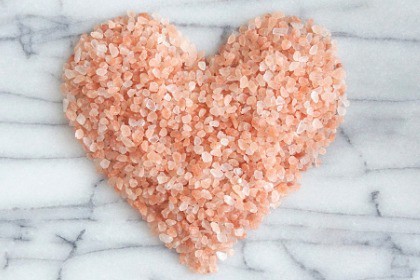
A double-blind placebo clinical study conducted by Fenestra Labs tested participants’ reactions to taking sea salt versus Himalayan sea salt. Researchers found Himalayan salt to be more effective at “normalizing mineralization” in the body. It also outperformed sea salt in being able to balance pH and lower oxidative stress in the body [2].
Let’s dive a little deeper into just what substances are found in those beautiful pink crystal salt rocks and how much they can benefit you and your health.
What Is Himalayan Salt & Where Does it Come From?
All Himalayan salt comes from the Jhelum District in the Punjab region of Pakistan. The ancient history of how this rosy-pink mineral came to be is fascinating. Like many areas of the world that are now dry land, the Himalayas currently stand where an ancient ocean used to be. When that body of water dried up about 300 million years ago, what was left was a vast salt deposit.
The largest mine in the area is the Khewra Salt Mine. Khewra sits at the foot of the Himalayas, a little over a hundred miles from the city of Islamabad. Unlike other parts of the world that used to be covered in ocean, the region of the Himalayas where the Khewra Salt Mine is located is protected from smog and other chemical pollutants by the Himalaya mountain range.
Himalayan pink salt is actually sea salt that is mined like rock salt. Experts estimate that it contains anywhere from 80 to 84 different kinds of major and trace minerals besides sodium. This is the main reason why all the yummy, good-for-you recipes on our blog call for pink Himalayan salt (or sea salt) in the ingredients – never iodized table salt.
Why Is Himalayan Salt Pink in Color?
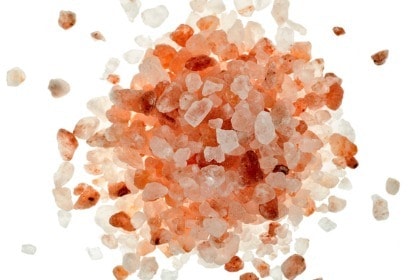
When shopping for Himalayan pink salt, you may notice that the salt crystals can range from the very faintest pink (almost clear) to a dark orangey-red in color.
The color comes from iron oxide (i.e., rust) found naturally in the salt deposits. While some people believe that the darker color must mean it’s healthier, it simply means it has more iron in it, which can actually give it a more bitter flavor for consumption.
There are countless different grades of quality and brands of Himalayan salt available for purchase. Many big chain stores like Sam’s, Costco, and Trader Joe’s all carry their own store brands of Himalayan salt. The average consumer likely won’t notice a big difference in taste between brands from just a sprinkle on their food, so go with what best suits your budget and culinary endeavors.
The Benefits of Trace Minerals in Pink Himalayan Salt
Trace minerals are minerals that are absolutely needed for the body, but just in smaller quantities than regular minerals. Some examples of trace minerals you may recognize include iodine, iron, copper, selenium, and zinc.
A little really does go a long way when it comes to trace minerals. Even though the body usually needs less than 100 milligrams of any one of them per day, significant consequences can result when we don’t get what we need. Just a few of the possible negative effects include [3]:
- mood issues
- reproductive issues
- weight gain
- cardiovascular complications
- digestive issues

Trace minerals are extremely important for dozens of functions in the body, including building enzymes, cleansing, and strengthening the blood and circulatory system, balancing hormones, reproductive health, and hundreds of other biochemical reactions that benefit the body and the brain.
The dozens of different kinds of trace minerals in Himalayan salt are the reason why including it in your diet can help your health on multiple levels – especially when used in place of table salt.
Studies over the years have indicated that ingesting Himalayan salt can [4]:
- help your detoxification system
- help you clear out the respiratory system
- lower inflammation
- strengthen the immune system
- boost longevity overall
Does Pink Himalayan Salt Have Iodine?
One of the key minerals found in Himalayan salt is iodine. That is great news since this is an essential mineral that we must get from food or supplementation. But does pink Himalayan salt have iodine in sufficient quantities that your thyroid and other organs that rely on iodine really need?
Why Your Body Needs Iodine
Just as your body needs sodium for a myriad of important functions, it also needs iodine. Iodine is the main source of “food” for the thyroid. Other areas need iodine for nourishment as well, such as the breasts and uterus area in women. Many women with breast cancer suffer from low iodine levels and thyroid dysfunction [5].

The thyroid is the “master hormone processor” in the body. It sends signals that basically tell all other hormones where to go and what to do. Balanced hormones are important for more than just reproductive health, and just the right amount of iodine is absolutely needed for your hormones to do their job effectively.
According to the National Thyroid Association, a significant 12% of the U.S. population are set to suffer from some kind of thyroid condition sometime in their lifetime [6]. For thousands of individuals, this will come in the form of hypothyroidism due to insufficient amounts of iodine. World Health Organization (WHO) statistics estimate that roughly 2 billion people worldwide are feeling the effects of iodine deficiency right now [7].
What’s more, your body does not need to be completely depleted to feel the consequences of a lack of iodine. Millions of people around the world (including in the U.S. and other western countries) actually suffer from subclinical iodine deficiency that can lead to hypothyroidism (defined by research as urinary iodine concentrations of less than 150 μg/L) [8].
Some of the signs of subclinical iodine deficiency may include:
- low energy/fatigue
- weight gain
- “brain fog”
- cold sensitivity
- gut issues
- chronic sore throat
- hair loss
- dry skin
- uterine fibroids/ reproductive issues in women
- prostate issues in men
- autoimmune conditions
If you have any of these issues on a regular basis, iodine deficiency may be to blame. Be sure to consult with a qualified health professional to discuss your options for healing!
Does Pink Himalayan Salt Have Enough Iodine to Correct Iodine Deficiency?
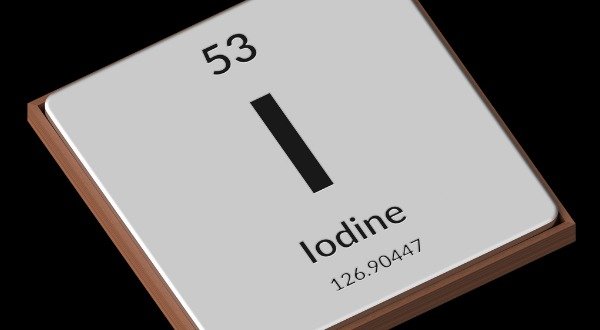
The obvious correction for iodine deficiency is to increase iodine levels in the body slowly and gently through iodine supplementation, while at the same time getting rid of halide toxins that block iodine absorption.
If you have already made the switch from iodized table salt to Himalayan or sea salt, that is definitely a step in the right direction! Remember that table salt is processed using bleaching agents which block iodine in the body. It may sound contradictory to think that a product which has iodine added to it actually strips iodine from the body. Crazy as this sounds, that’s exactly the case with iodized table salt.
It’s true that both sea salt and Himalayan salt naturally contain iodine, but is it enough to replace the depleted stores in your body that are caused by halide toxicity, poor eating habits, stress, and a myriad of other factors?
The answer, in a nutshell, is no.
The reason is that both Himalayan and sea salt contain only trace amounts of iodine, which is not enough to adequately supply all that your body needs. This is especially true when it comes to Himalayan and sea salt, which has a more refined flavor.
A little goes a long way when it comes to Himalayan salt and most sea salts, so most people tend to use less to get the same amount of flavor. This is great news for sodium levels since too much sodium can cause just as many problems in the body as not enough sodium can. It’s also great news for your budget!
Don’t Rely On Any Type of Salt to Meet Your Iodine Needs

Himalayan (and other sea salts) are an amazing addition to any spice cabinet, and we highly suggest replacing the table salt that may be in your salt and pepper duo with nutrient-rich pink Himalayan salt if you haven’t don’t so already. The synergy of all those trace minerals within it just can’t be beaten.
At the same time, you’ll also need to include other foods rich in iodine in your diet.
We also suggest that supplementing with a quality iodine product just makes sense in our toxic world. But unfortunately, not all types of iodine supplements are alike and some even contain harmful ingredients. Many others are just a waste of money since you would have to consume the whole bottle to get enough absorbable minerals to do your body any good.
Choose Organixx Nascent Iodine for Safe and Gentle Absorbability
When it comes to making your iodine supplement work for you, absorbability is the key. It is also the hiccup point for this essential mineral. This is because most forms of supplemental iodine do not absorb well in the body.
Many experts agree that the best form of iodine in terms of both gentleness and absorbability is nascent iodine. This form of iodine is also called atomic iodine, monatomic iodine, atomidine, or colloidal iodine.
Nascent iodine is superior because of how it is structured at the molecular level. It contains an incomplete number of electrons, which gives it an electrical charge. This allows it to not be absorbed in the digestive tract like most supplements, but to go directly to the specific organs that are most hungry for it [9].
Organixx Organic Nascent Iodine provides you with one of the most important minerals for your entire body in a way that you cannot get from even the most complete foods – including pink Himalayan and sea salt.
When your organs are working hard to detoxify, you want the purest form of iodine possible to help them work more efficiently. It only makes sense to use an organic form that’s totally natural and free of chemicals. Organixx Iodine is one of the only formulas that is USDA Certified Organic. It’s a pure, nascent form of iodine which your thyroid can use immediately.
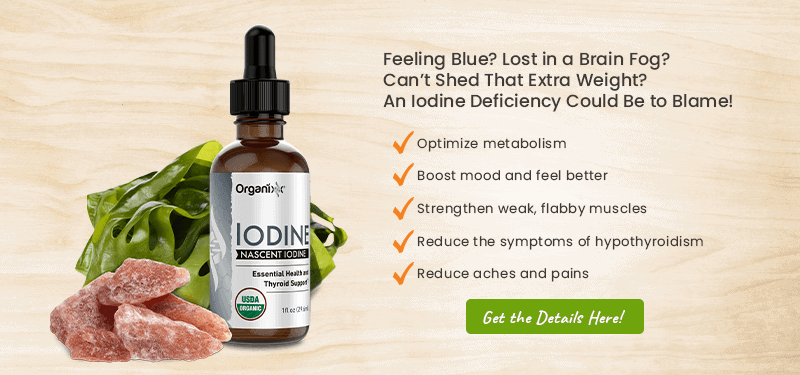
Over 2 billion people around the world will drink a cup of tea today [1]. In fact, tea is the second most commonly consumed beverage after water! Whether you consider yourself a tea connoisseur or not, there’s one kind of tea you should know about if you’re at all interested in good health. It’s called matcha green tea powder and you’ll be amazed at the health benefits it has for your body – ranging from increased metabolism to improved detoxification to a stronger immune system.
What’s the Difference Between Matcha and Green Tea Powder?

All non-herbal teas – black, green, and white – come from the same plant, Camellia sinensis. What makes them different largely revolves around the timing of when the leaves are picked and how they’re processed after picking.
Matcha is green tea that is produced in its own unique way. The plants are shade-grown and the leaves are picked by hand so they are devoid of stems. Once picked, the leaves are lightly steamed and then placed in cold storage where they’re left to dry and mature. Eventually, they’re ground into a fine powder.
True Matcha Comes From Japan
Matcha green tea powder is manufactured exclusively in Japan using techniques that have been in practice for over 800 years! You may see “green tea powders” for sale that are exported from China and Korea and are typically factory processed… but they’re not true “matcha” unless produced in Japan in the traditional manner.
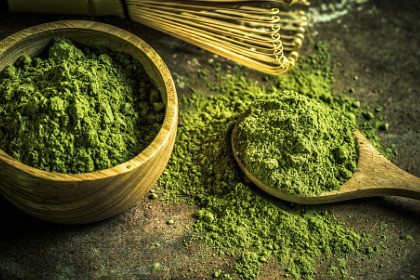
Because matcha green tea is created using minimal processing and little heat, the matcha green tea powder maintains a larger quantity of phytonutrients than other green teas. We’ll talk about some of these phytonutrients in the next section.
Just to give you a sneak peek at how the green tea antioxidants in matcha stack up against regular green tea…
According to a University of Colorado study, matcha green tea contains concentrations of cancer-busting epigallocatechin gallate (EGCG) that are 137 times greater than regular green tea [2]!
4 Health Benefits of Matcha Green Tea
#1. Matcha Supports the Liver with Chlorophyll
Matcha contains chlorophyll. This is the super-detoxifying substance that gives this type of tea its bright green color. Chlorophyll is known for how it can protect the liver. A substance called chlorophyllin in this phytonutrient has the ability to inhibit the mutation of key enzymes responsible for liver disease and hepatocellular carcinoma (the most common type of liver cancer in adults) [3].
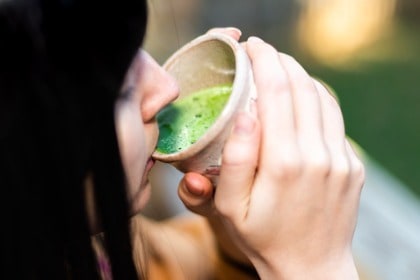
Research conducted by the Linus Pauling Institute and Johns Hopkins University also found that chlorophyll can lower the risk of liver damage caused by mycotoxins (a kind of poisonous mold) in food [4]. Because matcha is produced using shade-growing techniques, the leaves are able to retain higher levels of chlorophyll than regular green tea. These amazing liver-boosting benefits are then passed on to you!
#2. Matcha Promotes Energy-Enhancing Brown Fat Cells
A 2017 Japanese trial published in the American Journal of Clinical Nutrition found that consuming matcha green tea can activate brown fat tissue. The study, which was published in the American Journal of Clinical Nutrition, discovered that when participants added matcha to their diet, the rate of energy overall that the body was able to expend rose from 10% per day to 43% per day [5].
Brown Fat Cells vs. White Fat Cells: What’s the Difference?
Believe it or not, there are good and bad kinds of fat. “White fat” is the most common kind of fat and is created when we ingest more calories than we burn. White fat cells store toxins deep inside their tissue.

When white fat accumulates around the midsection, it can be a sign of metabolic syndrome and a higher risk of chronic conditions such as:
- sleep apnea
- arthritis
- diabetes
- cancer [6]
“Brown fat,” on the other hand, is the kind you want to have around! Brown fat contains more cellular mitochondria for greater energy conversion and less “storage.” This revs up metabolism and creates heat in the body, helping you burn energy instead of just storing it [7].
According to experts, more brown fat on the body (and less white fat) is equated with greater weight loss and better efficiency of all the organs, including those having to do with detoxification [8].
#3. Matcha Green Tea Powder Is a Brain Detoxifier
When we think about detoxifying the body, we often don’t think about the toxins that are able to pass through the blood-brain barrier and make their way into our grey matter. It’s these tiny toxins, however, that are a big culprit behind the epidemic of neurodegenerative disease we see today.

According to the Alzheimer’s Association, 5 million older Americans are diagnosed with Alzheimer’s Disease each year [9]. Many more suffer from milder cognitive conditions such as brain fog and mood-related disorders like anxiety/depression.
Supporting your brain health through eating right, exercising, balancing your gut microbiome, and taking key supplements will help kickstart the process of removing pathogenic esters, gases, and the remnants of heavy metals from the nervous system and the brain area itself.
Matcha green tea can greatly help in this regard because it contains several key substances that support brain health. The hormones of stress, namely cortisol and adrenaline, act as toxins that can catalyze systemic inflammation.
This can have a direct effect on brain tissue integrity, according to researchers at the University of California, Berkeley [10]. Matcha includes a high amount of the amino acid L-Theanine, which has been proven to lower stress responses and encourage alpha brain waves [11].
Matcha green tea powder also contains a moderate amount of caffeine. Caffeine is high in antioxidants and can be a benefit for many individuals when taken in the right quantities [12].

Caffeine and L-Theanine, in the specific quantities found in matcha green tea, prove to be a winning combination for maintaining “relaxed alertness” and lowering stress-related toxins at the same time.
Finally, matcha is also neuroprotective because of certain antioxidant polyphenols that are found in all green tea, and in higher than normal amounts in matcha.
According to a 2004 study conducted by the Israeli Rappaport Family Research Institute, the polyphenols found in green tea are neuroprotective for both Alzheimer’s and Parkinson’s disease. This is due in large part because of these substances’ ability to detoxify the brain and reduce oxidative stress [13].
#4. Match Green Tea Is Super Immune-Supportive
We can’t talk about what matcha green tea powder does for your detoxification pathways without touching on its amazing benefits for the immune system as well! The immune system and the detoxification system work hand-in-hand in discovering, destroying, and eventually eliminating pathogenic (disease-causing) substances from the body.
The main component of matcha green tea responsible for fortifying immune function is the phytonutrient epigallocatechin gallate, or EGCG, mentioned earlier. EGCG has the ability to support and protect the production of T cells. It also helps the immune system fight infection directly [14].
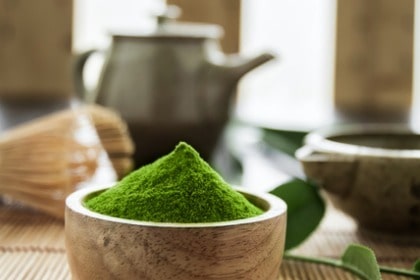
Many researchers have analyzed the immune-supporting qualities of ECGC, especially when it comes to cancer. A 2018 study conducted by the University of Salford in England found that the amount of EGCG in matcha can actually “reprogram the metabolism of cancer cells [15].” Other research shows that ECGC can have an effect on cancer stem cells [16].
The Benefits of Matcha Green Tea Powder
If you’re a “die-hard” tea drinker and also love matcha’s unique, slightly earthy taste, then you may not have any trouble getting a cup or two of this amazing detoxifying and disease-preventing substance in your system each day.
If tea is not your thing or you’re short on time, you can still benefit from all the health advantages of matcha by using an all-in-one formula that combines matcha’s amazing properties with other key detoxifying substances such as milk thistle, dandelion, and marshmallow root.
However you decide to do it, consider adding matcha green tea to your list of “must-haves” to support detoxification and whole-body health!
Organixx Cleanse & Detoxx is a two-step formula that provides a gentle yet powerful full-body detox using organic botanical ingredients. Naturally purge your body of toxins, chemicals, free radicals, heavy metals, waste, as well as bacteria, and pesticides. Easily cleanse your colon, liver, kidneys, lungs, and lymphatic system resulting in increased energy, and better digestion with more nutrient absorption, in addition to improved immunity, mental clarity, and overall health and wellbeing.
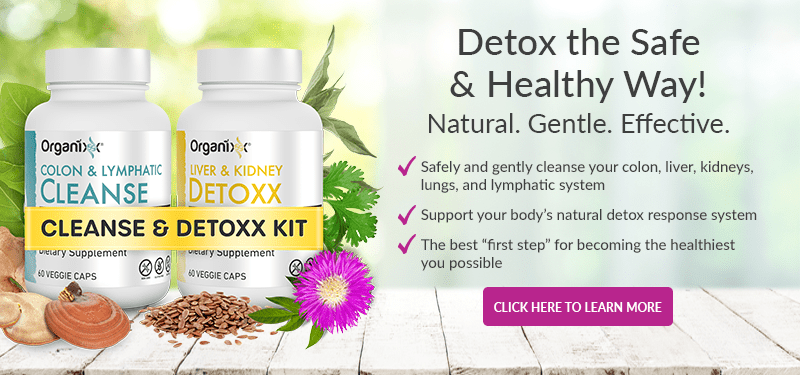
Astragalus as an Adaptogen
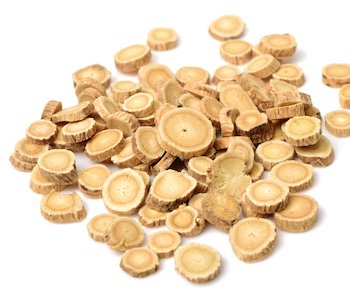 Not surprisingly, astragalus has been in the Chinese traditional medicine pantheon for centuries.
In most cases, only the root of the astragalus plant is used medicinally, and of the thousands of kinds of astragalus plants, only astragalus mongholicus and astragalus membranaceus are typically harvested for healing.
There are several qualities that make astragalus root so powerful for balancing the human body. One of these is its adaptogenic properties.
In a nutshell, adaptogens do what their name implies: they help the body adapt to stressful conditions. This is why they can be so beneficial for a plethora of health conditions.
According to the National Institutes of Health’s National Center for Complementary and Integrative Health (NIH-NCCI), “Astragalus has been used as a dietary supplement for many conditions, including for diarrhea, fatigue, anorexia, upper respiratory infections, heart disease, hepatitis, fibromyalgia, and as an adjunctive therapy for cancer [1].”
Adaptogens do their job mostly through the way they are able to regulate hormones, especially cortisol levels. Natural ways for regulating stress hormones can be especially helpful for those who suffer from chronic stress.
According to the American Psychological Association’s 2017 Stress in America study, more than 40% of all U.S. adults admit that they often “lie awake at night because of stress [2].”
Cortisol is the primary stress hormone that is pumped into the body when a person is in “fight or flight” mode. It is a potentially helpful hormone in the body, but only under certain conditions. Too much of it will lead directly to inflammation and a higher risk for disease.
Stress management techniques like meditation can be very helpful for lowering cortisol levels, but sometimes they are simply not enough. Adaptogens help the body “turn off” cellular receptors for cortisol in a natural and safe way, while “turning on” signaling for calming and healing hormones and processes [3].
Not surprisingly, astragalus has been in the Chinese traditional medicine pantheon for centuries.
In most cases, only the root of the astragalus plant is used medicinally, and of the thousands of kinds of astragalus plants, only astragalus mongholicus and astragalus membranaceus are typically harvested for healing.
There are several qualities that make astragalus root so powerful for balancing the human body. One of these is its adaptogenic properties.
In a nutshell, adaptogens do what their name implies: they help the body adapt to stressful conditions. This is why they can be so beneficial for a plethora of health conditions.
According to the National Institutes of Health’s National Center for Complementary and Integrative Health (NIH-NCCI), “Astragalus has been used as a dietary supplement for many conditions, including for diarrhea, fatigue, anorexia, upper respiratory infections, heart disease, hepatitis, fibromyalgia, and as an adjunctive therapy for cancer [1].”
Adaptogens do their job mostly through the way they are able to regulate hormones, especially cortisol levels. Natural ways for regulating stress hormones can be especially helpful for those who suffer from chronic stress.
According to the American Psychological Association’s 2017 Stress in America study, more than 40% of all U.S. adults admit that they often “lie awake at night because of stress [2].”
Cortisol is the primary stress hormone that is pumped into the body when a person is in “fight or flight” mode. It is a potentially helpful hormone in the body, but only under certain conditions. Too much of it will lead directly to inflammation and a higher risk for disease.
Stress management techniques like meditation can be very helpful for lowering cortisol levels, but sometimes they are simply not enough. Adaptogens help the body “turn off” cellular receptors for cortisol in a natural and safe way, while “turning on” signaling for calming and healing hormones and processes [3].
Astragalus Root Benefits and the Immune System
One of the main benefits of astragalus root in the healing methods of ancient Chinese doctors was its immune-boosting effects. First, astragalus works on immune system function itself. A 2012 Beijing study published in the journal Fitoterapia found that astragaloside IV, a phytochemical extract from Astragalus mongholicus, has the ability to regulate pro-inflammatory cytokines that can affect certain T cells [4]. In addition, a 2004 study conducted at Peking University and published in Biochemical and Biophysical Research Communications shed some light on the way polysaccharides in astragalus membranaceus help to regulate the immune system. According to researchers [5],“We herein demonstrate that APS [astragalus membranaceus] activates mouse B cells and macrophages, but not T cells, in terms of proliferation or cytokine production.”But that’s not all when it comes to how astragalus can benefit the immune system. Inflammation is at the root of many diseases. A unique 2008 study conducted at the University of Texas-Houston Medical School and published in the Journal of Medicinal Food looked at the adaptogens goldenseal and astragalus and their effects on pro-inflammatory cytokines in the body. Talking about both herbs, the researchers hypothesized that “their historical use as therapeutic agents may be due to reduction in the pro-inflammatory response that indirectly leads to limiting of clinical symptoms during infection [6].” Interestingly, it was also discovered that Astragalus membranaceus was able to influence the production of tumor necrosis factor (TNF)-α when used in high concentrations. TNF is a pro-inflammatory immune system cell that plays a role in apoptosis (programmed cell death). Finally, astragalus directly helps the immune system do its job because of its known antioxidant and anti-bacterial properties via polysaccharide substances. A 2012 study published in the International Journal of Molecular Science found that astragalus was able to protect mitochondria by preventing oxidative stress [7]. According to the University of Maryland Medical Center, “In the United States, researchers have looked at astragalus as a possible treatment for people whose immune systems have been weakened by chemotherapy or radiation. In these studies, astragalus supplements seem to help people recover faster and live longer [8].”
Astragalus Root for Detoxification
 As if all of the above isn’t enough, astragalus can also be used to strengthen and support major detoxification pathways, especially the liver and kidneys.
Your liver is perhaps your most important organ for overall detoxification in this highly-toxic world.
According to research done at Anhui Medical University in Hefei, China, extract of Astragalus membranaceus can protect the liver against cellular damage and liver fibrosis by supporting mechanisms in the body that hunt out liver cancer cells and destroy them.
In this study, investigators combined astragalus extract with extract from the common garden flower Chinese peony. They concluded that “taken together, the present data provides evidence that PAE (extracts of Paeonia lactiflora and Astragalus membranaceus) is a potent antineoplastic drug candidate for the treatment of HCC [hepatocellular carcinoma, the most common form of liver cancer] [9].”
As if all of the above isn’t enough, astragalus can also be used to strengthen and support major detoxification pathways, especially the liver and kidneys.
Your liver is perhaps your most important organ for overall detoxification in this highly-toxic world.
According to research done at Anhui Medical University in Hefei, China, extract of Astragalus membranaceus can protect the liver against cellular damage and liver fibrosis by supporting mechanisms in the body that hunt out liver cancer cells and destroy them.
In this study, investigators combined astragalus extract with extract from the common garden flower Chinese peony. They concluded that “taken together, the present data provides evidence that PAE (extracts of Paeonia lactiflora and Astragalus membranaceus) is a potent antineoplastic drug candidate for the treatment of HCC [hepatocellular carcinoma, the most common form of liver cancer] [9].”
Astragalus Can Benefit the Kidneys
A meta-analysis conducted by the Cochrane Database of Systematic Reviews summarized that “Astragalus may help to decrease the serum creatinine, reduce the amount of protein lost in urine, and diminish the effects of some complications, such as anaemia and malnutrition [10].” Studies in Korea shed light on how astragalus does this. Researchers at Kangwon National University and Konkuk University discovered that one of the main components of astragalus, TAT2 or Cycloastragenol, not only helps the brain, but may also provide nourishment for the kidneys [11]. Still, others have focused on how astragalus can help with diabetes-related kidney damage, also known as diabetic nephropathy. Several studies have focused on this link, so much so that astragalus extract has become a common part of natural protocols for individuals with both type 1 and type 2 diabetes. Not only can astragalus help restore the kidney for diabetics, but it can also help increase insulin sensitivity. Finally, researchers at Fudan University’s Huashan Hospital in Shanghai, China conducted a meta-analysis on astragalus’ effect on the kidneys of diabetics. The report, published in the January 2011 edition of the Journal of Ethnopharmacology, concluded that “the role of Astragalus in the treatment of DN [diabetic nephropathy] can be disclosed and [is] of profound significance [12].”Astragalus for Longevity
The newest astragalus research has been focusing on its benefits for longevity, especially where cognition and DNA repair is concerned. There have been several studies on this to date, and many of them have narrowed in on astragalus root’s beneficial effect on telomeres. Telomeres are bits of DNA located at the end of each chromosome that help protect them from damage. Telomeres are maintained by the enzyme temomerase and, sadly, most individuals today do not have enough telomerase available to prevent ongoing telomere damage. Telomeres shorten with age as well as stress, and can lead to disease and rapid aging. On the other hand, telomeres can be lengthened through healthy eating, lifestyle changes, and proper supplementation. Scientists at the Spanish National Cancer Centre in Madrid found that astragalus (used in a commercial formula called TA-65) was able to elongate short telomeres and help repair “associated DNA damage [13].” Astragalus root was supposedly a core herbal supplement taken by Chinese herbalist and martial artist Li Ching Yuen, who 19th-century newspapers and government reports claim to have lived to be over 250 years old! While that may seem hard to believe, what we do know is that astragalus’ powerful restorative, anti-inflammatory, and balancing phytochemical components can absolutely lead to a healthier body and mind as well as a more vibrant life long-term. The Madrid researchers also found that TA-65 led to improvements in “health-span indicators,” including greater glucose tolerance, improvement in osteoporosis conditions, healthier skin, and less incidence of cancer. Another study conducted by the Dalian Nationalities University in Dalian, China found that the herb’s polysaccharides seemed to influence both the brain and the body, which may lengthen human life span in general [14].Astragalus Root Benefits are Enhanced by Other Herbal Powerhouses
There is no doubt that astragalus root is a powerhouse for the body when taken alone. It is also clear that astragalus works even better (and possibly in a more targeted way) when combined with other health-supporting herbs. If all this evidence doesn’t convince you that astragalus really is one of the great healing herbs for boosting the immune system, detoxifying the body, and helping you live healthier and longer, then nothing will! This humble root herb from the Chinese herbal pantheon is definitely one to add to your own herbal cabinet for overall great health.Astragalus is an Ingredient in Organixx Colon & Lymphatic Cleanse
Astragalus is in Organixx Colon & Lymphatic Cleanse, part of the 2-step system in the Organixx Cleanse & Detoxx Kit. It’s one of 10 powerful herbs selected for their ability to gently cleanse your colon and support your lymphatic system.Organixx Cleanse & Detoxx is a two-step formula that provides a gentle yet powerful full-body detox using organic botanical ingredients. Naturally purge your body of toxins, chemicals, free radicals, heavy metals, waste, as well as bacteria, and pesticides. Easily cleanse your colon, liver, kidneys, lungs, and lymphatic system resulting in increased energy, and better digestion with more nutrient absorption, in addition to improved immunity, mental clarity, and overall health and wellbeing.

Is turmeric good for a woman’s health? At this point, it’s arguably one of the most-studied botanicals on the planet. What over 13,000 studies on turmeric and curcumin indicate is that this food/supplement has an astonishing array of health benefits that are especially favorable for women. If you’ve never thought about turmeric for women’s health… read on to discover 10 of the most exciting curcumin/turmeric benefits for women.
Note: Turmeric is the popular name for the rhizome of the Curcumae longa plant. Curcumin is one of the active ingredients (compounds) found in turmeric.
#1. Curcumin Helps Protect Against Breast Cancer
Breast cancer is the number two killer of women in the U.S., second only to heart disease. Curcumin has been found in many studies to have chemopreventive action, which means that it is able to interfere with the cancer process.
Chemopreventive nutrients are generally broken down into three distinct sub-groups:
- anti-proliferants (stopping the rapid growth of cancer cells)
- antioxidants (combing the body for free radicals), and/or
- carcinogen (cancer-causing) blockers
Curcumin sits in all three sub-groups [1]. In other words, it works against cancer in all three ways!
Curcumin promotes cellular death receptors [2,3], which are receptors sitting on the surface of cells that transmit the “die” message to cancer cells. Curcumin also has significant anti-inflammatory properties [4-8], which is important because cancer is known to be an inflammatory process.
Another way curcumin helps fight breast cancer is through apoptosis in breast cancer cells [9-13]. Apoptosis is programmed cell death, which is a process absent in cancer cells. Curcumin also helps inhibit the HER-2 oncogene which can make this type of breast cancer more aggressive [14].
Curcumin has also been found to inhibit the growth of new blood vessels which tumors use to feed themselves; a process known as angiogenesis [15,16]. It also inhibits the rapid growth and division of cancer cells [17-20] and activates key enzymes which act to destroy cancer cells from within [21,22].
And, should you already have cancer and be taking chemotherapy and/or radiation treatment, curcumin has been shown to increase the sensitivity of tumor cells to these therapies while protecting healthy tissues from the harmful effects of those treatments [23-25].
It’s important to note that none of this is to say that turmeric/curcumin supplementation is a stand-alone treatment or cure for cancer. But it may be worth discussing with your healthcare provider if it would be beneficial as a complementary therapy.
#2. Curcumin Helps With Reduced Inflammation

Inflammation is the product of a complex series of biological responses triggered by the immune system. It is a life-saving response to outside threats, so vital for our health.
However, when inflammation becomes chronic, it can create a firestorm of problems. Chronic inflammation is caused by a myriad of factors and lies at the root of many chronic diseases, including (but not limited to):
- Cancer
- Cardiovascular disease
- Rheumatoid arthritis
- Allergies and asthma
- Diabetes
- Inflammatory bowel disease
- Atherosclerosis
- Neurological problems (including Alzheimer’s disease)
- Heart disease
Over 100 clinical trials indicate that curcumin powerfully targets numerous inflammatory pathways in the body yielding reduced inflammation. Even more impressively, curcumin has been shown in some studies to match the effectiveness of many anti-inflammatory drugs… without the side effects [26-28].
#3. Curcumin Helps Decrease Risk of Heart Disease
More women die of heart disease than any other health condition. Again, chronic inflammation is at the root of the problem, although other factors such as diet and stress levels play a role in the development of heart disease.
According to Chinese research published in the journal Molecules [29], curcumin suppresses numerous pro-inflammatory pathways in the body, is a potent antioxidant and free radical scavenger, reduces cholesterol, and guards against cardiac hypertrophy (enlarged heart) and fibrosis.
These antioxidative and anti-inflammatory benefits combined equate to improved cardiovascular health.
#4. Curcumin Helps Protect Against Neurodegenerative Diseases
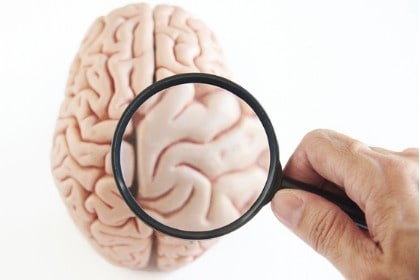
Brain health is an important concern for women, who are being afflicted with Alzheimer’s disease at far higher rates than men. It is estimated that by 2030, one in five people over the age of 65 will be diagnosed with a neurodegenerative disease.
The research suggests that an overabundance of free radicals and oxidative stress, the formation of beta-amyloid plaques, and cerebral deregulation caused by heavy metal toxicity and chronic inflammation all contribute to neurodegenerative diseases such as Alzheimer’s disease.
In studies, curcumin has been shown to decrease beta-amyloid plaques, delay the degradation of neurons (brain cells) in the brain, and protect brain cells.
Curcumin also chelates (latches onto) the heavy metals that are doing such damage, decreases inflammation, neutralizes free radicals, and decreases the formation of microglia (dysfunctional microglia are a prominent feature of Alzheimer’s). Curcumin has also been shown to be beneficial for other nerve-related disorders such as Huntington’s and Parkinson’s disease [30,31].
As an added bonus, curcumin helps guard against declining cognitive function. A 2016 clinical trial [32] comprising older adults found that daily consumption for six months of a curcumin product protected the curcumin group from declining cognitive function – an outcome not enjoyed by the placebo group.
#5. Curcumin Helps Prevent Type 2 Diabetes
The U.S. Centers for Disease Control and Prevention (CDC) recently released a report stating that 30.3 million Americans (9.4% of the U.S. population), had type 2 diabetes as of 2015. Another 84.1 million had prediabetes, a condition that, if left untreated, can lead to the development of type 2 diabetes within five years [33].
Type 2 diabetes is a chronic condition that in turn leads to long-term complications such as heart, liver, and kidney disease. An abundance of studies has revealed the critical role of inflammation and oxidative stress in the development of type 2 diabetes.
Curcumin has been shown to lower blood sugar in people with diabetes and inhibit key enzymes linked with type 2 diabetes. Further, curcumin is known to inhibit a number of inflammatory pathways [34] and has the ability to slow the progression of diabetic retinopathy (damage to the blood vessels of the eyes), which is a common complication of type 2 diabetes [35].
#6. Curcumin May Aid in Weight Loss

As women approach middle age, many find it more challenging to maintain a healthy weight. A 2013 study done at the School of Medicine and Biomedical Sciences, State University of New York at Buffalo, found that curcumin just may assist with the obesity epidemic we’re currently facing.
The study explained that obesity is characterized by chronic low-grade metabolic inflammation. Because curcumin acts directly on key inflammatory factors, it appears to decrease the rapid growth of fat cells! Researchers stated that “curcumin directly interacts with white adipose tissue to suppress chronic inflammation [36].”
Curcumin has been shown in animal studies to increase metabolism, improve insulin resistance, and lower cholesterol levels [37] – all factors that help in the “battle of the bulge.”
#7. Curcumin Helps Promote Mental Health
Depression is prevalent in menopausal women but also afflicts many younger women. Because curcumin has some interesting and beneficial effects on the nervous system, it has been recently studied for its effects on depression.
One 2017 review of medical research found that curcumin “appears to be safe, well-tolerated, and efficacious among depressed patients [38].” Here’s why…
Already noted are the anti-inflammatory and antioxidant properties of curcumin. For the nervous system, these two aspects of curcumin make it a special nutrient.
Curcumin turns on genes that produce antioxidants that scour for free radicals and limit their damage. It also supports the synthesis of glutathione, a potent antioxidant and neuroprotective agent in the brain.
As discussed above, curcumin inhibits inflammatory enzymes. This is helpful in depression because inflammation leads to changes in the ability of the brain to regulate important hormones, including adrenal, sex, and thyroid hormones.
Inflammation also reduces the production of important neurotransmitters in the brain such as serotonin. Chronic inflammation also induces changes in the plasticity (the ability to make new neural pathways) of the brain.
Curcumin tackles all of these problems that contribute to depression [39].
#8. Curcumin May Help Endometriosis Pain

Endometriosis is an inflammatory condition that affects an estimated 1 in 10 women of reproductive age (approximately 176 million women worldwide). It is an often painful condition where tissue that normally lines the inside of the uterus starts growing in other parts of the body such as the ovaries, fallopian tubes, and pelvis.
If left untreated, endometriosis can result in infertility.
A 2013 cell study [40] found that curcumin had beneficial effects on endometrial cells, noting that the hormone estradiol is an important promoter of endometrial growth. Researchers stated that curcumin suppressed the proliferation (rapid growth) of endometrial cells by reducing estradiol levels.
A 2018 review [41] of medical studies on curcumin and endometriosis found that in both test tube and animal studies, curcumin reduced the pain and inflammation of endometriosis. Further, curcumin inhibited the invasion, attachment, and new blood vessel growth of endometrial lesions, all of which had the combined effect of inhibiting the progression of the disease. Researchers stated that clinical trials would be necessary to ultimately prove its benefits for humans
#9. Curcumin Is a Blood Purifier and Natural Detoxifying Agent
A real concern of modern-day living is from the toxins found in our air, food, and water. One word for toxins is “xenobiotics,” which essentially means a chemical found in the body that isn’t supposed to be there.
Xenobiotics are often harmful chemicals associated with increased inflammation and a higher risk of cancer. The liver, as it filters the blood, plays a major role in the detoxification and excretion of xenobiotics and other potentially dangerous substances.
According to research published in the journal Plant Foods for Human Nutrition [42] back in 1993, turmeric assists the liver in detoxifying xenobiotics, helps to ease some of the effects of these substances, and protects the cells of the liver.
A 2013 clinical trial [43] also found that turmeric extracts acted as a blood purifier, aiding the health of the liver. Fermented turmeric powder was given to study participants with elevated liver enzymes for 12 weeks. At the conclusion of the trial it was found that for those taking the turmeric, liver enzymes were significantly reduced.
#10. Curcumin Helps Protect Against Colds and Flu
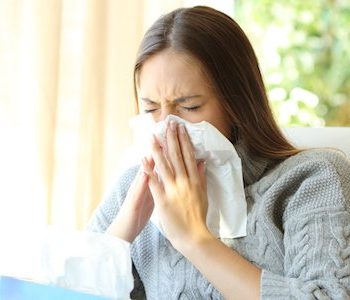
Because curcumin is a powerful antioxidant and helps fight the formation of free radicals, it also supports the body against colds and flu.
An abundance of free radicals destroys healthy cells, which makes us more prone to catching seasonal colds and flu. Studies consistently show that curcumin stimulates the immune system and helps the body fight off colds and flu; especially the drug-resistant strains of flu [44].
A 2018 study [45] found that curcumin has the ability to directly inactivate influenza A virus and inhibit associated influenzal pneumonia, making it an important anti-viral substance.
An Important Note About Curcumin Absorption
An often-asked question is “Can I just eat turmeric root to get the good benefits of curcumin?”
While there is no doubt that using turmeric spice in your cooking has great health benefits (and is tasty to boot!), even taking a high dose of curcumin does not guarantee it will be absorbed by the body. While many supplement brands use black pepper to increase the bioavailability of curcumin, there are some downsides to combining turmeric and black pepper.
Another important consideration is that tumeric has blood-thinning properties which can impact blood clotting and increase the risk of bleeding and bruising. Always consult with a trusted healthcare practitioner to determine if a supplement is right for you.
Turmeric 3D from Organixx provides you one of the most “bioavailable” forms of turmeric due to its unique fermentation process. This means your body experiences the maximum benefits of the purest, most potent turmeric available!
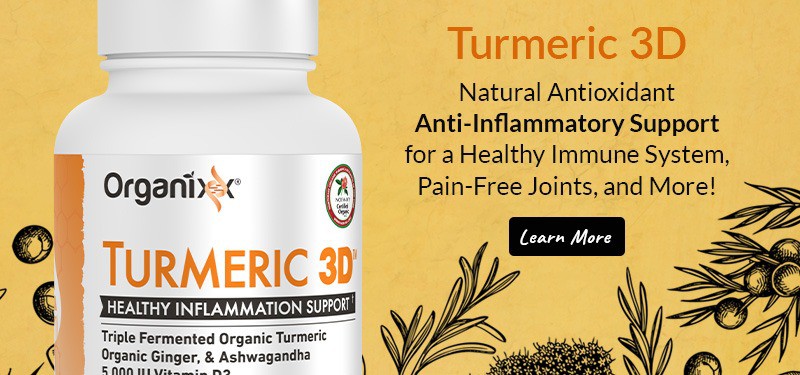
The well-known Chinese medicinal herb yin yang huo (scientific name Epimedium) is also known popularly as “horny goat weed,” “rowdy lamb herb,” and “bishop’s hat.” It was likely first used in traditional Chinese medicine (TCM) as a natural aphrodisiac 2000 years ago [1,2].
This hardy, heart-shaped plant can be found growing in the wild in Asia, including in China, and in Europe. It may have gotten its name when herders noticed that their goats became more sexually active after grazing on Epimedium plants.
name when herders noticed that their goats became more sexually active after grazing on Epimedium plants.
In a natural progression from animals to humans, Epimedium has been used for centuries in TCM to help counter fatigue and sexual dysfunction (including erectile dysfunction), and boost both male and female libido.
Modern science has confirmed these properties of Epimedium, along with its newly discovered ability to protect nerve cells and promote their growth, lower atherosclerosis risk, reduce inflammation, and perhaps even slow down aging. More on each of these below.
Over the past few years, researchers have isolated more than 260 biologically potent compounds from this versatile plant, including its main flavonoid component icariin, along with other flavonoids, polysaccharides, and sterols.
Let’s take a closer look at some of the compelling evidence for Epimedium’s proposed biological actions when it comes to sexual potency.
The Main Types of Erectile Dysfunction
 Erectile dysfunction (ED) is estimated to affect around 20 million men in the U.S. and can be categorized either as primary ED – a rare condition in which a man may never have been able to sustain an erection – or secondary ED, typically caused by stroke, diabetes, or an injury.
Erectile dysfunction (ED) is estimated to affect around 20 million men in the U.S. and can be categorized either as primary ED – a rare condition in which a man may never have been able to sustain an erection – or secondary ED, typically caused by stroke, diabetes, or an injury.
Additionally, medications for high blood pressure, depression, high cholesterol, cancer, and long-term pain have been known to cause ED or contribute to it.
Scientific Research Into Solutions for ED
In a 2007 laboratory study, consumption of Epimedium extract was seen to help improve erectile function in aged male rats [3]. In separate studies, Epimedium’s main active component icariin, while helping to boost erectile potency, did not have much of an effect on testosterone levels [4-6].
Exciting new research suggests that Epimedium might be just as effective for male libido as the well-known “little blue pill” – but with fewer side effects.
For instance, in 2008, researchers from the University of Milan in Italy tested four plants that are used as natural aphrodisiacs in traditional cultures, along with three individual compounds [7,8].
The blue pill works by blocking the actions of an enzyme known as phosphodiesterase-5, or PDE5, which helps to control blood flow to the penis. In short, suppressing PDE5’s activity promotes male erections [9].
Icariin Is a Compound in Epimedium
In the Italian study, of the four plants tested, only Epimedium and its main active component icariin were able to block PDE5.
Next, the study researchers created six chemically modified versions of icariin, which they also tested on PDE5. The most efficient of these, compound 5, apparently works just as well as the blue pill – and is likely to cause fewer side effects.
This is because the active ingredient in the blue pill also affects phosphodiesterase enzymes (PDEs) other than PDE5 and can 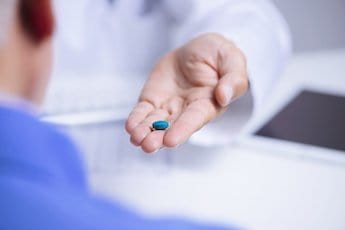 therefore harm vision and heart function.
therefore harm vision and heart function.
Compound 5 is very specific in that it only blocks PDE5. Indeed, icariin has been shown to have up to 100-fold specificity for PDE5 relative to other PDEs [10].
Therefore, it is unlikely to affect other organs like the active ingredient in the blue pill does.
Along with inhibiting PDE5’s actions, icariin at low doses also induces the enzyme nitric oxide synthase, likely leading to increased production of the gaseous compound nitric oxide (NO) – which is known to dilate blood vessels and improve local blood flow [11]. This may also help to improve erectile function.
Protecting Nerve Cells and Promoting their Growth
Icariin has been shown to have neuroprotective and neuroregenerative properties in multiple studies [12-18].
For instance, in a 2013 laboratory study, Epimedium extract and icariin were seen to help promote the recovery of damaged nerves and improve their re-growth relative to both icariin and control, although icariin was better than control [19,20].
Further, flavonoid compounds from Epimedium have been shown to promote the proliferation and differentiation of neural stem cells in laboratory experiments, suggesting that these compounds may promote neuronal growth [21].
Icariin appears to protect brain cells – known scientifically as neurons – by inhibiting pro-oxidant and pro-inflammatory markers in response to stress [22,23].
In a laboratory mouse model with an early onset and rapid advancement of senescence, or aging, icariin treatment for 15 weeks was seen to prevent aging-related learning and memory losses via various mechanisms, including the prevention of oxidative damage [24].
Intriguingly, icariin and its derivatives have been shown to extend lifespan and maintain DNA stability in nematode worms known as C. elegans as well as in mice [25,26]. Indeed, there is some preliminary evidence to suggest that icariin may be useful in treating age-related diseases [27].
Lowering Atherosclerosis Risk
 Atherosclerosis is a disease in which plaque builds up inside the arteries.
Atherosclerosis is a disease in which plaque builds up inside the arteries.
Emerging evidence suggests that icariin can protect against DNA damage, correct defects in the cells lining blood vessels, prevent the proliferation and migration of smooth muscle cells, suppress inflammatory responses, and prevent platelet activation. Together, these actions appear to contribute to icariin’s ability to lower atherosclerosis risk [28].
Reducing Inflammation
Laboratory studies show that icariin can limit the extent of inflammation in lung and immune cells, as well as in a rat model of asthma [29-31].
Epimedium: Side Effects
Side effects associated with Epimedium consumption appear to be caused by taking high doses of the herb for prolonged periods of time. These can include spasms, breathing problems, sweating, reduced thyroid function, irritability and aggression, nausea, a racing heart, and feeling hot [32,33].
In one instance, a patient reported rash, pain, and a burning sensation after taking Epimedium with ginkgo, while another patient with congestive heart failure was hospitalized with symptoms of shortness of breath, chest pain, and irregular heartbeat.
Epimedium may affect hormone levels, especially estrogen, and should be completely avoided by patients with hormone-sensitive cancers or with heart disease [34].
If you’re not getting all the nutrients and antioxidants you need from food, your best source is whole food vitamins. Organixx Multi-Vita-Maxx contains 21 uniquely fermented vitamins and enzyme-activated minerals that are more “bioavailable” and easily absorbed by your body than the synthetic compounds found in most supplements.
More than two centuries ago, Peruvians discovered that a tuberous vegetable growing high in the Andes mountain range had some noticeable benefits for their health and endurance. Men going into battle or performing other physical feats would take maca because they observed that it gave them stamina, strength, and virility.
Meanwhile, women who consumed maca had better reproductive health, energy, and focus. Does maca have something special in it that confers all of these benefits? Read on to discover just what it is that makes maca so marvelous.
What Is Maca?
Growing at an elevation of 12-14,000 feet above sea level in the Andes mountains of Peru, maca grows in extreme weather 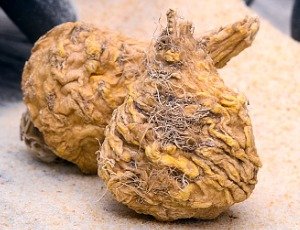 conditions. Thriving in a habitat of intense sunlight, cold temperatures, and strong winds, this tuberous plant is a part of the brassica family. Just like cauliflower, broccoli, and cabbage, maca is a cruciferous vegetable.
conditions. Thriving in a habitat of intense sunlight, cold temperatures, and strong winds, this tuberous plant is a part of the brassica family. Just like cauliflower, broccoli, and cabbage, maca is a cruciferous vegetable.
Nutrients Found in Maca
Maca contains plenty of healthy fatty acids, the most abundant being linoleic, oleic, and palmitic acids. Maca contains vitamins A, C, B2, B6, and niacin, as well as minerals – zinc, iron, iodine, copper, calcium, potassium, and magnesium. Nine amino acids are considered essential for optimal health, and maca contains seven of them [1].
Maca is also a rich source of plant sterols, which are part of what makes it so beneficial for hormonal health. Plant sterols are (chemically speaking) structurally similar to the body’s own hormones such as estrogen, progesterone, and testosterone.
Maca Is an Adaptogen
So how exactly does it work? Maca is an adaptogen, meaning that it works to strengthen, balance, and help the body respond to internal and external changes and stressors. It regulates the production of hormones to maintain healthy organ function. Maca feeds the hypothalamus, pituitary, and adrenal glands, known as the Master Glands (more on that later).
Maca’s plant sterols appear to stimulate changes in the action of the hypothalamus, pituitary, and adrenal glands. Maca also seems to exert an influence on the ovaries, pineal gland, and thyroid.
How Maca Can Aid Fluctuating Hormones
Premenstrual Syndrome (PMS) is one of the most common complaints among women of reproductive age. When out of balance, estrogen – the hormone responsible for regulating the reproductive system – can cause a wide range of symptoms and annoyances for women (and their men!).
Mood swings, water retention, fatigue, food cravings, irritability, headaches, irregular menstrual periods, painful cramping… all can be attributable to estrogen imbalance.
Maca can help ease the rapid rise and fall of hormones in menstruating women due to its adaptogenic properties. Also, by improving the connection between the brain and the pituitary gland, maca’s ability to help balance levels of circulating hormones is further enhanced. Most PMS sufferers taking maca report a marked improvement in symptoms during their first menstrual period after commencement of maca.
Other times when maca may be of benefit to women is after coming off birth control pills, and after having a baby and breastfeeding has ceased. At such times, endocrine system function can be depleted, and maca’s adaptogenic properties mean it can help the body right itself again.

Maca can also ease many of the symptoms of perimenopause and menopause. For those harried by hot flashes, night sweats, insomnia, depression, anxiety, and lack of energy, maca can provide some much-needed relief. Maca does not appear to mimic estrogen in the body but it can help to increase the body’s production of estrogen if levels are too low. That’s the beauty of an adaptogenic herb: it adapts to what the body needs.
In a 2006 clinical trial, 34 early-postmenopausal women were given a supplement containing either maca or a placebo twice per day for four months. Those receiving the maca had increased levels of estrogen, suppressed levels of FSH, T3 thyroid hormone, adrenocorticotropic hormone, and cortisol (the hormone secreted in response to stress). Body mass index also decreased. Iron levels increased, however, as did bone density markers, and maca relieved many of the symptoms of menopausal discomfort such as hot flashes and night sweats [2].
Another small 2014 clinical study found that maca reduced blood pressure and depression in postmenopausal women [3].
Can Maca Can Also Benefit Men?
Maca can also be helpful for male health. Recent studies have indicated that maca may assist male health by helping to increase sperm count and motility, increasing sexual desire, protecting the prostate and reducing the incidence of benign prostatic hyperplasia, reducing stress and depression, boosting energy levels, and easing mild erectile dysfunction [1, 4].
8 Additional Health Benefits of Maca
#1. Boosts Energy and Endurance
A 2009 study of male cyclists found that maca supplementation did indeed improve cycling time performance, as well as sexual desire (a perk for many) [5].
#2. Hypothalamus/Pituitary/Adrenal (HPA) Gland Nourishment
HPA glands are called the “Master Glands” because they regulate other glands (you may also hear it termed the “HPA Axis”). When HPA is well nourished, other glands of the body benefit as well. When under stress, the adrenal gland takes a big hit, especially if the stress moves from acute (short-lasting stress) to chronic (long-lasting stress).
Maca feeds all three glands by supporting the body’s production of hormones, either increasing or decreasing levels according to the need. As a result, maca may help prevent or repair adrenal exhaustion and all of the unhealthy follow-on effects this has on the body and mind.
#3. Libido Booster
Maca has been used traditionally by Peruvians to boost virility and libido. Science has not yet determined how maca does this, but it has been called “Nature’s Viagra” for good reason.
Some health experts believe maca’s effects on libido may be caused by its long-chain fatty acids known as macaenes and macamides, which are unique and have not been found in any other plant.
A 2008 clinical study followed women suffering from sexual dysfunction caused by selective serotonin reuptake inhibitors (SSRIs) for depression. The study found that three grams of maca per day gave significant improvement in libido for the women taking it [6].
#4. Cardiovascular Health
Maca’s phytosterols – campesteroland beta-sitosterol, act to interfere with the absorption of LDL cholesterol (the so-called “bad” cholesterol), making maca beneficial for the cardiovascular system [7]. Phytosterols have also been studied for their anti-inflammatory effects, which assist in balancing the immune system, and, as an added bonus, help to protect the body from abnormal cell growth.
cholesterol (the so-called “bad” cholesterol), making maca beneficial for the cardiovascular system [7]. Phytosterols have also been studied for their anti-inflammatory effects, which assist in balancing the immune system, and, as an added bonus, help to protect the body from abnormal cell growth.
#5. Anti-Cancer
A 2015 study found that phytosterols interfere with many different pathways in the carcinogenesis (cancer beginning) process [8]. In addition, an animal study found that beta-sitosterol decreased levels of circulating estrogen, and inhibited the growth of estrogen-receptor positive breast cancer tumors [9].
#6. Boosts Immunity
The phytosterols in maca stimulate the immune system and increased levels of interleukin-2 and natural killer cells [7] which the body needs to fight abnormal cell growth.
#7. Liver Support
Being a cruciferous vegetable, maca contains glucosinolates which, when chewed and digested, change into health-promoting chemicals that help protect against cancer. Sulfur-containing glucosinolates form bonds that help the body’s enzymes do their work better.
Both sulfur and plant sterols are required in the production of a master antioxidant called glutathione which boosts liver function and helps the liver with detoxification [10].
#8. Healthy Bones
Maca’s vitamins and minerals can help to build strong, healthy bones. A 2006 clinical trial found that maca increased bone density markers for the early-postmenopausal women taking it [2].
How to Take Maca
Look for organic maca powder grown in Peru. Maca can be added to juices, oatmeal, inside sandwiches, sprinkled on salads, and added to raw food recipes. Just keep in mind that it is best not to heat maca powder to high temperatures which might diminish some of its nutrients. If you use it in recipes, add it after cooking, just before serving.
A gentle approach is generally the best way to begin taking maca.
Recommendations are to start with a small dose of 1 teaspoon per day. If that is well tolerated, gradually increase the dose to 1 tablespoon, or more. If you haven’t noticed any improvement, remember one trial had women taking 3 grams per day.
It can take two or three weeks before you may notice the full benefits of maca. It is also recommended to only take maca daily for a few months and then take a break from it for a month or so before resuming consumption again.
Some health experts recommend avoiding maca under the following conditions. Please consult with your own healthcare provider if:
- you are between the ages of 15 and 35, have a good, mainly plant-based diet, and don’t have mood swings, fluid retention, or any of the symptoms of PMS
- you have an allergy to iodine
- you have Hashimoto’s disease or hyperthyroid condition
If hormonal fluctuations are creating havoc in your life, consult your natural health practitioner to see if maca might be right for you.



